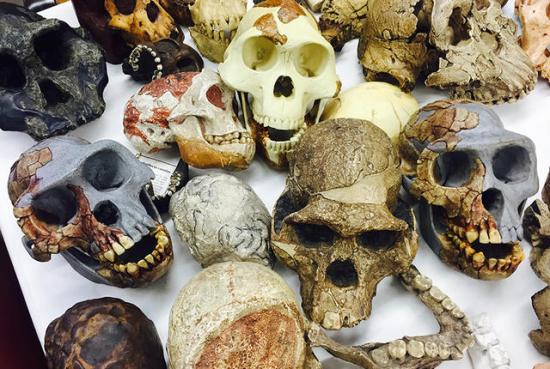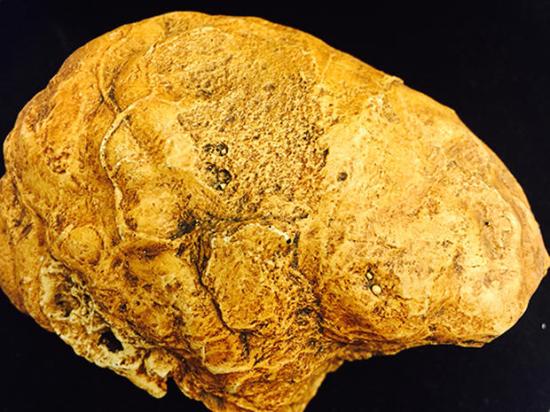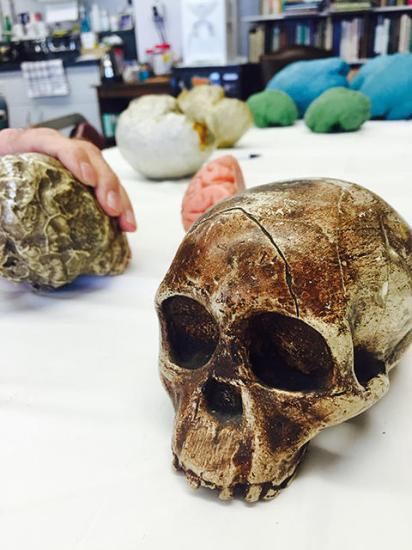Jen Pinkowski
Source - http://mentalfloss.com/article/70306/tracing-evolution-human-brain-through-casts-inner-skull?
 Part of the collection of early hominid skull reproductions at Columbia University. Image credit: Jen Pinkowski
Part of the collection of early hominid skull reproductions at Columbia University. Image credit: Jen Pinkowski
You might think of your skull as a hard case keeping your tender brain safe and sound. And that’s mostly true. But living bone is dynamic and responsive, and your brain is a “throbbing, vital, organic thing,” says Dean Falk, an evolutionary anthropologist at Florida State University and one of the world’s leading researchers on the evolution of the human brain. As she explains, “The pressure inside the skull in living individual animals makes impressions inside the walls of the braincase.”
These impressions can remain on the inside of the skull long after the brain itself has decomposed—in some cases, for many millions of years.
Some paleoanthropologists have capitalized on this tendency for the skull to retain phantom impressions of the organ that was once inside it by creating casts of the interior of the cranium. They're called endocasts.
 An endocast made by Columbia University paleoanthropologist Ralph Holloway. Image credit: Jen Pinkowski
An endocast made by Columbia University paleoanthropologist Ralph Holloway. Image credit: Jen Pinkowski
An endocast is a cast of the hollow interior of an object, most commonly the skull of a vertebrate (then also known as an endocranial cast). Some are natural, the result of sediment filling the brain cavity; others are intentional, formed from clay, latex rubber, plaster of Paris, plasticine, or silicone. Still others are entirely digital, composed of high-tech scans that reveal the interior surface in closer detail.
Paleoneurologists, who study the evolution of the brain, use endocasts to study its size, shape, and surface morphology. By tracing how these characteristics have changed during our evolutionary history, they’ve gained deeper insight into the ways we’ve become the humans we are today, with a suite of characteristics we now consider essentially, singularly human.
mental_floss spoke to Falk and to Ralph Holloway, a Columbia University paleoanthropologist and another of the world's leading researchers on the evolution of the human brain, about what they have learned from decades of research on endocasts about brains both ancient and modern. We also spoke to Falk about her (sure to be controversial) theory that key milestones in our brain's evolution explain Asperger's syndrome.
FROM HORSE HEADS TO HUMAN BRAINS
The endocast emerged as a tool in paleoneurology in the first half of the 20th century thanks to the pioneering work of German paleontologist Ottelie “Tilly” Edinger. The daughter of the prominent 19th-century comparative anatomist (and University of Frankfurt co-founder) Ludwig Edinger, Tilly discovered that vertebrate brains leave imprints on the interior of the skull while studying the brain cavity of a Mesozoic marine reptile. After the animal’s death, its skull had filled with sediment that eventually hardened to stone, creating a sort of “fossil brain.” This natural endocast retained an imprint of the reptile brain exterior.
Intrigued, Edinger began looking into endocasts, which until then had generally been treated as curiosities by comparative anatomists like her father, who had focused on the flesh of recently deceased animals. Working mostly alone, Edinger organized taxonomically the endocasts she located in a variety of museum collections, and analyzed her findings. In 1929, she published Die fossilen Gehirne (Fossil Brains). This scholarly tome would prove to be highly influential in the use of endocasts as a way to study ancient brains that no longer existed in the flesh.
Her second seminal work, Horse Brains, in 1948, contained a key insight about the evolution of the mammalian brain that made as much of an impact as her first work. “She found that [brain] volume and organization were sort of in league with each other,” says Holloway. “There were periods of time in which the horse brain seemed to be reorganizing, and there were other times in which it seemed to be changing in size.”
That insight—that changing size and reorganization are both essential to brain evolution—would become key to our understanding of how our own brains developed. Though in earlier decades scientists had unearthed ancient hominids in various places—including Neanderthals in Europe, Homo erectus in Asia, and, crucially, a variety of hominids and ancient primates in Africa—more were emerging from the dirt and rocks by mid-century. This trend continued into the 1970s, when the use of endocasts became more common. (Of course, paleoanthropologists have continued to unearth hominids in the decades since. The most recent find is Homo naledi.)
One of the first endocasts Holloway made, in the late '60s, was of Taung child, who died around age 3 from an eagle attack in southern Africa between 2 and 3 million years ago. After death, the skull had filled with sediment, eventually forming a natural endocast. In 1925 Raymond Dart had assigned this child a new species, Australopithecus africanus, and claimed it was an intermediary between human and ape—an idea that was largely rejected for decades. Holloway's analysis helped cement Dart's case for Taung child as a legitimate link between apes and us.
 Ralph Holloway holds the endocast he made of Taung child's skull, seen in a reproduction at front. In the background, a variety of hominid endocasts (and one pink chimp). Image credit: Jen Pinkowski
Ralph Holloway holds the endocast he made of Taung child's skull, seen in a reproduction at front. In the background, a variety of hominid endocasts (and one pink chimp). Image credit: Jen Pinkowski
Holloway used latex rubber early on (it's now largely degrading), plaster of Paris, and eventually plasticine. “I like to have something in my hand,” Holloway says. “I can take the clay and mold things around. I can sort of get a range of what I think is possible.” Today he also uses a silicone material.
Falk, meanwhile, initially chose liquid latex, which she'd pour inside, swirl around, and cure for hours; to expedite the process, she’d sometimes blow a hair dryer on it. Once the cast was set, she'd extract the hollow mold and pop it into shape. In 1980, Falk also made an endocast of Taung child and came to very different conclusions from Holloway; she thought then that its brain was more apelike than human. The two have argued in academic journals for decades about their differing interpretations of Taung child, especially about the location, size, and very existence of the lunate sulcus, a C-shaped furrow on the occipital lobe, the visual processing center of the brain.
Today digital endocasts are far more common; these are CAT scans that can be done even of sediment-filled natural endocasts like Taung's. A virtual endocast is now Falk's preferred method. Her virtual endocast of Homo floresiensis, the so-called Hobbit hominid discovered on the Indonesian island of Flores in 2003, bolstered its finders' argument that the small creature represents a new Homo species (which some still dispute).
The quality of an endocast depends on species, size, and age, Falk says. “Juveniles make really good endocasts. With old people, the brains start to shrink a little bit, and remodeling inside the skull will kind of erase some of the impressions.”
Hominid endocasts are measured for brain size and analyzed for visible features, and then compared to other brains. “We can follow these endocasts up to the present, when we actually have real brains,” Falk says. “And you can compare them to brain morphology from living apes, monkeys, and humans. You can also do endocasts of fossil primates.”
Endocasts are used by many paleoneurologists, in Europe, Africa, and the U.S. In America, two of the largest collections were created by Falk and Holloway; each has made hundreds of endocasts.
Endocasts have their limitations. The main drawback is that they only capture details on the surface of the brain, and the details they do preserve largely depend on the quality of cranial preservation. “In terms of the organization that you see on the outside surface of the brain, the endocasts can be murky,” Falk admits. “It's touch and go whether or not you're going to get much detail, or which part of the brain will show up [on the endocast]."
Nor can many brain changes that accompanied shifts in behavior show up on the outside surface of the brain, since many occurred internally. “Take bipedalism, for example,” Holloway says. “Bipedalism can’t be divorced from changes in the brain. Obviously a whole series of new motor cortex connections are being made. Something like bipedalism is extraordinarily complicated in terms of the neural anatomy involved. The problem is, when you have a skull that’s 3 million years old and you make an endocast of it, you can’t see anything, really, about those kinds of behaviors.”
PART.2